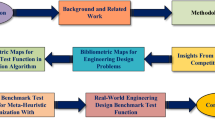Abstract
Level of repair analysis (LORA) is an approach used during the design stage of complex equipment for analysis of the cost effectiveness of competing maintenance strategies. LORA is carried as a part of the life cycle cost and cost of ownership analysis and plays a significant role in minimizing the life cycle cost and cost of ownership of the capital equipment. Since many purchasing decisions of complex equipment are based on cost of ownership, it has become essential to carry out LORA to compete in the market. In this paper, we develop a mathematical model for LORA and propose a solution methodology based on genetic algorithms. The concept is illustrated using a hypothetical aircraft engine.
Similar content being viewed by others
References
Asiedu, Y. and P. Gu. (1998). “Product Life Cycle Cost Analysis: State of the Art Review.” International Journal of Production Economics 36(4), 883–908.
Barros, L. and M. Riley. (2001). “A Combinatorial Approach to Level of Repair Analysis.” European Journal of Operational Research 129, 242–251.
Barros, L. (1998). “The Optimisation of Repair Decisions Using Life Cycle Cost Parameters.” Institute for Mathematics and Its Applications Journal, 9(4), 403–413.
Blanchard, B. S. and W. J. Fabrycky. (1991). Systems Engineering and Analysis. Prentice Hall.
Blanchard, B. S., Dinesh V., and E. L. Peterson. (2000). Maintainability—A Key Effective Serviceability and Maintenance Management, John Wiley, New York.
Degraeve, Z. and F. Roodhooft. (1999). “Improving the Efficiency of the Purchasing Process Using Total Cost of Ownership: The Case of Heating Electrodes at Cockerill Sambre S.” A. European Journal of Operational Research 112, 42–53.
Dinesh Kumar et al. (2000). Reliability, Maintenance and Logistic Support—A Life Cycle Approach. Kluwer Academic Publishers.
Ebling, C. E. (1997). An Introduction to Reliability and Maintainability Engineering. McGraw Hill.
Haupt, R. and S. E. Haupt. (1998). Practical Genetic Algorithms. John Wiley / Sons.
Hatch, M. L. and R. D. Badinelli. (1999). “Concurrent Optimization in Designing for Logistic Support.” European Journal of Operational Research, 115, 77–97.
Holland, J. H. (1975). “Adaptation in Natural and Artificial Systems.” University of Michigan Press.
Jayabalan, V. and D. Chaudhuri. (1992). “Cost Optimization of Maintenance Scheduling for a System with Assured Reliability.” IEEE Transactions on Reliability. 41, 21–25.
Knezevic, J. (1997). Systems Maintainability—Analysis, Engineering and Management. Chapman / Hall, London.
Makis, V. A. and K. S. Jardine. (1993). “A Note on Optimal Replacement Policy Under General Repair.” European Journal of Operational Research, 69, 75–82.
Park, P. S. (1979). “Optimal Number of Minimal Repairs Before Replacement.” IEEE Transactions on Reliability, 28, 137–140.
Plank, E. R. and B. G. Ferrin. (2002). “How Manufacturers Value Purchase Offerings An Exploratory Study.” Industrial Marketing Management 31, 457–465.
Sherif, S. Y. and W. J. Kolarik. (1981). Life Cycle Costing: Concept and Practice. Omega, 9 (3), 287–296.
Sherbrooke, C. C. (1992). Optimal Inventory Modelling of Systems. John Wiley, USA.
Spears, W. M. and K. A. De Jong. (1991). “An Analysis of Multi-Point Crossover.” In Foundations of Genetic Algorithms (Ed.) G J E Rawlins, Morgan Kauffmann.
Taylor, W. B. (1981). “The Use of Life Cycle Costing in Acquiring Physical Assets.” Long Range Planning, 14(6), 32–43.
Waeyenbergh. G. and L. Pintelon. (2002). “A Framework for Maintenance Concept Development.” International Journal of Maintenance Concept Development, 77, 299–313.
Woodward, D. G. (1997). “Life Cycle Costing – Theory, Information, Acquisition and Application.” International Journal of Project Management 15, No. 6, 335–344.
Zhand Z. G. and C. E. Love. (2000). “A Simple Recursive Markov Chain Model to Determine the Optimal Replacement Policies Under General Repairs.” Computers / Operations Research 27, 321–333.
Zhang, L. S., D. D. Estrin, S. Shenker, and D. Zappala. (1993). “RSVP: A Resource ReSerVation Protocol.” IEEE Network Magazine.
Author information
Authors and Affiliations
Corresponding author
Rights and permissions
About this article
Cite this article
Saranga, H., Kumar, U.D. “Optimization of aircraft maintenance/support infrastructure using genetic algorithms—level of repair analysis”. Ann Oper Res 143, 91–106 (2006). https://doi.org/10.1007/s10479-006-7374-1
Issue Date:
DOI: https://doi.org/10.1007/s10479-006-7374-1




